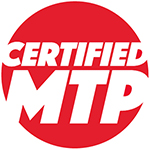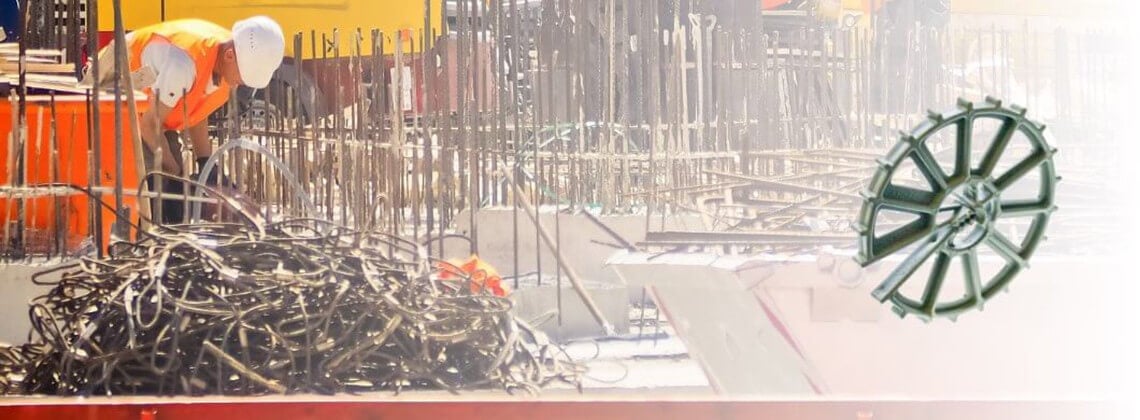When you’re planning a pour for structural or architectural concrete, you want to know that the proper rebar spacing and mesh spacing you use will provide the support and strength that they’re supposed to. Proper spacing is required to ensure that the rebar and mesh are positioned correctly before you begin pouring concrete. At Certified Material Testing Products, we carry certified concrete testing products and accessories that will make your job much easier.
With a full line of Concrete Accessories, you can set up your rebar framework in no time at all. We carry leveling shims, spacers, rebar saddles, and more. Our spacer wheels will ensure that the rebar in your sidewalls and columns is properly covered and that they don’t shift during your pour. If you have larger pieces of rebar, these support chairs will work with any diameter, and all you’ll have to do is wire-tie the rebar to them.
Certified Concrete Testing Products for Perfect Rebar Spacing
It’s never good to have to break out poured concrete due to inadequate coverage for your Rebar Spacing and Mesh Spacing, that’s moved during your pour. Get the results you need the first time by shopping with us for certified concrete testing products. Whether you’re building a column, a load-bearing wall, a bridge, or a tunnel, our products and accessories will serve you perfectly in the field. You’ll be able to feel confident and know that your concrete is solid and secure and that the rebar or mesh inside is properly spaced and covered, giving you maximum support for the rest of your construction project.
If you need to purchase any materials testing equipment to replace or add to your lab supplies, shop at Certified Materials Testing Products for your one-stop shop for all your testing products. We have the knowledge and equipment to back you up when you need it most. Start shopping online with us today and find exactly what you are looking for. Contact us now to have any of your questions or concerns answered
Overview of Rebar Spacing and Mesh Spacing
Rebar Spacing and Mesh Spacing are critical components in reinforced concrete construction, providing the necessary structural strength and durability to various concrete structures. This 1000-word overview delves into the principles, standards, applications, and considerations of rebar and mesh spacing in construction projects.
Importance of Proper Rebar Spacing and Mesh Spacing
1. Structural Integrity: Proper spacing ensures that the concrete and steel work together effectively to resist different loads and stresses, maintaining the structural integrity of the building or structure.
2. Crack Control: Adequate spacing helps control the width and distribution of cracks in concrete, which can occur due to shrinkage and temperature changes.
3. Durability: Correct spacing contributes to the durability of the structure by preventing corrosion of the reinforcement, especially in aggressive environments.
4. Compliance with Codes: Adhering to prescribed spacing guidelines is essential for meeting building codes and standards, which dictate the minimum and maximum spacing for different applications.
Principles of Rebar Spacing and Mesh Spacing
1. Uniform Stress Distribution: Spacing is designed to distribute stresses uniformly across the reinforcement, preventing stress concentrations that can lead to failure.
2. Bonding: Adequate spacing ensures a good bond between the concrete and the steel reinforcement, crucial for the transfer of stresses.
3. Concrete Cover: Ensuring sufficient concrete cover over the reinforcement protects it from environmental factors and corrosion.
Standards and Codes
Rebar and mesh spacing guidelines vary depending on regional and national building codes, such as the American Concrete Institute (ACI) standards, Eurocode 2 in Europe, and other national standards like BS (British Standards) and IS (Indian Standards). These codes specify minimum and maximum spacing limits, cover requirements, and other design considerations.
Calculating Rebar and Mesh Spacing
1. Minimum Spacing: Typically, the minimum spacing is determined based on the maximum aggregate size in the concrete mix. A common guideline is that the spacing should be at least equal to the largest aggregate size plus a certain margin.
2. Maximum Spacing: Governed by structural requirements and crack control needs. Maximum spacing is often limited to ensure adequate performance under load and to control crack widths effectively.
3. Optimal Spacing: Engineers calculate optimal spacing based on load requirements, concrete properties, and environmental conditions, balancing structural performance with material efficiency.
Types of Rebars and Mesh
1. Rebars: Available in various grades and sizes, the most common types include deformed bars (with ridges for better bonding) and plain round bars.
2. Welded Wire Mesh: Consists of a series of wires welded at intersections, used in concrete slabs and walls for reinforcement.
Applications in Construction
1. Slabs on Grade: Rebar or mesh spacing is crucial for these slabs to manage tensile stresses caused by temperature changes and drying shrinkage.
2. Walls and Columns: Vertical reinforcement spacing is vital for load-bearing walls and columns to ensure they can support the structure’s weight.
3. Foundations: Proper spacing in foundations like footings and raft foundations is essential for distributing loads and preventing differential settlement.
4. Bridges and Heavy Infrastructure: Requires meticulous planning of rebar spacing to handle dynamic and heavy loads.
Installation Considerations
1. Placement Accuracy: Precise placement according to the design specifications is critical for the reinforcement to perform as intended.
2. Tying and Welding: Rebars are either tied or welded at intersections to maintain spacing during concrete pouring and curing.
3. Supports and Spacers: Used to maintain the correct position and cover of the reinforcement within the concrete.
Challenges and Solutions
1. Congestion: In areas with dense reinforcement, maintaining proper spacing can be challenging. Solutions include using smaller diameter bars or higher-grade steel to reduce congestion.
2. Corrosion Protection: In aggressive environments, additional considerations like epoxy-coated rebar or increased concrete cover are necessary.
3. Quality Control: On-site inspections and adherence to detailed reinforcement plans are crucial for ensuring proper spacing and placement.
Environmental and Sustainability Considerations
1. Material Optimization: Efficient design and spacing can reduce the quantity of steel needed, lowering the environmental footprint.
2. Recycled Materials: Using recycled steel for rebar and mesh contributes to sustainability in construction.
Technological Advancements
1. 3D Modeling and BIM: Advanced modeling techniques like Building Information Modeling (BIM) help in precise planning and visualization of rebar and mesh placement.
2. Automated Rebar Tying Tools: Enhance efficiency and accuracy in tying rebars, especially in large-scale projects.
Future Trends
The future of rebar and mesh spacing in construction points towards increased precision through digital tools, sustainable materials, and innovative designs that optimize material use while enhancing structural performance.
Conclusion
Rebar and mesh spacing are fundamental aspects of reinforced concrete construction, directly impacting the safety
Related Blogs for Rebar Spacing and Mesh Spacing
Top Rebar Chairs for Concrete: Stability for Your Project
Choosing the Best Rebar High Chair for Construction
Footer Rebar: Stability in Foundation Construction
Rebar Clips: Enhancing Construction Stability and Efficiency
Top Safety Caps for Rebar: Protection on Construction Site
Rebar Chair: Choosing the Perfect Chair for Construction
Plastic Rebar Chairs: Construction with Stability
Chair Rebar: Stability and Strength in Concrete Projects
Rebar Chairs: Support for Concrete Reinforcement Projects
Rebar Wire Ties: Guide for Strong Concrete Reinforcement
Top Rebar Spacer Options for Durable Concrete Construction
Rebar Detection: Tools for Detecting Rebar in Concrete
How to Measure Rebar Diameters

